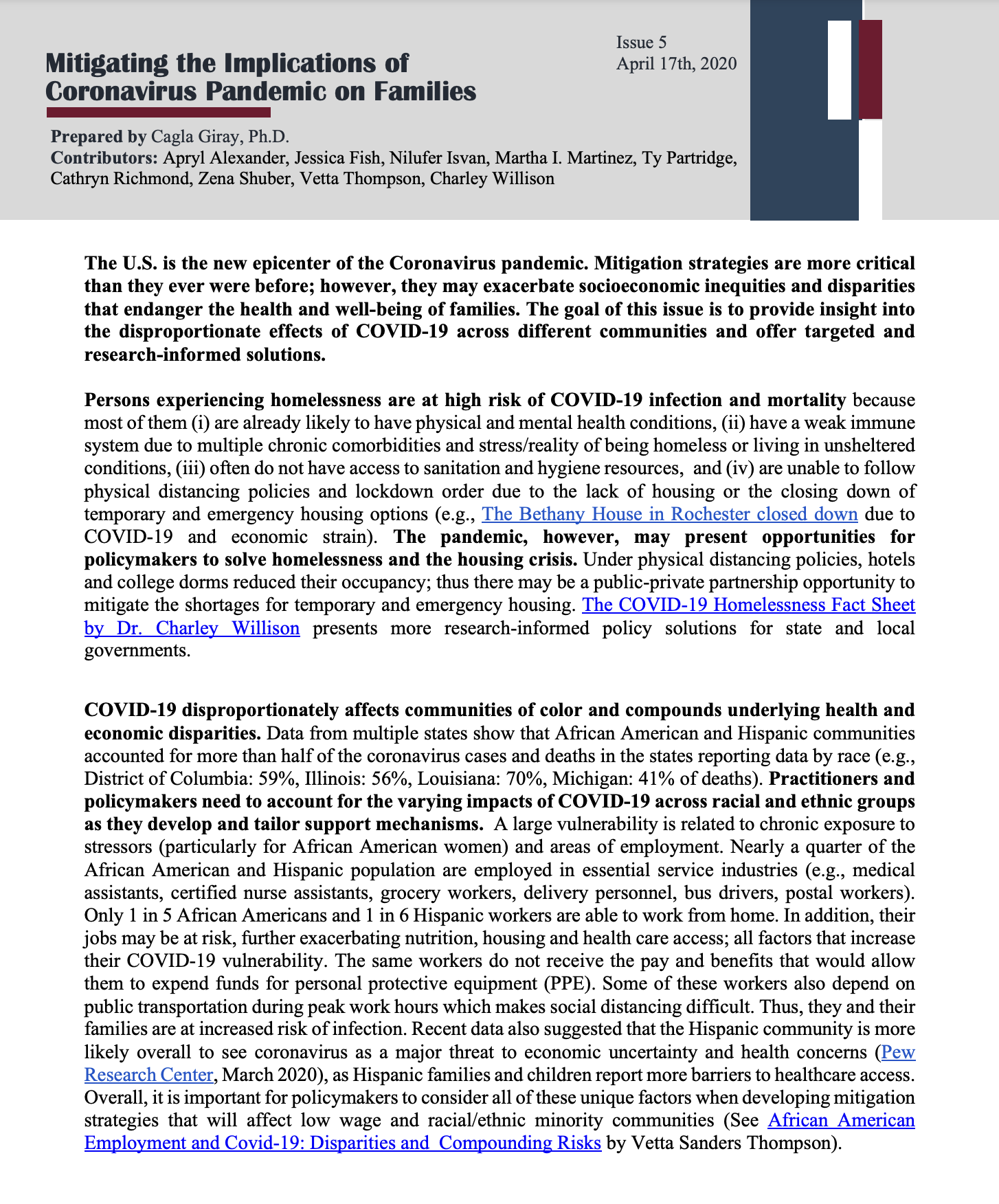
The U.S. is the new epicenter of the Coronavirus pandemic. Mitigation strategies are more critical than they ever were before; however, they may exacerbate socioeconomic inequities and disparities that endanger the health and well-being of families. The goal of this issue is to provide insight into the disproportionate effects of COVID-19 across different communities and offer targeted and research-informed solutions.
Persons experiencing homelessness are at high risk of COVID-19 infection and mortality because most of them (i) are already likely to have physical and mental health conditions, (ii) have a weak immune system due to multiple chronic comorbidities and stress/reality of being homeless or living in unsheltered conditions,(iii)often do not have access to sanitation and hygiene resources, and(iv)are unable to follow physical distancing policies and lockdown order due to the lack of housing or the closing down of temporary and emergency housing options (e.g., The Bethany House in Rochester closed down due to COVID-19 and economic strain). The pandemic, however, may present opportunities for policymakers to solve homelessness and the housing crisis.Under physical distancing policies, hotels and college dorms reduced their occupancy; thus there may be a public-private partnership opportunity to mitigate the shortages for temporary and emergency housing. The COVID-19 Homelessness Fact Sheet by Dr. Charley Willison presents more research-informed policy solutions for state and local governments.
COVID-19 disproportionately affects communities of color and compounds underlying health and economic disparities. Data from multiple states show that African American and Hispanic communities accounted for more than half of the coronavirus cases and deaths in the states reporting data by race (e.g., District of Columbia: 59%, Illinois: 56%, Louisiana: 70%, Michigan: 41% of deaths). Practitioners and policymakers need to account for the varying impacts of COVID-19 across racial and ethnic groups as they develop and tailor support mechanisms. A large vulnerability is related to chronic exposure to stressors (particularly for African American women) and areas of employment. Nearly a quarter of the African American and Hispanic population are employed in essential service industries (e.g., medical assistants, certified nurse assistants, grocery workers, delivery personnel, bus drivers, postal workers). Only 1 in 5 African Americans and 1 in 6 Hispanic workers are able to work from home. In addition, their jobs may be at risk, further exacerbating nutrition, housing and health care access; all factors that increase their COVID-19 vulnerability. The same workers do not receive the pay and benefits that would allow them to expend funds for personal protective equipment (PPE). Some of these workers also depend on public transportation during peak work hours which makes social distancing difficult. Thus, they and their families are at increased risk of infection. Recent data also suggested that the Hispanic community is more likely overall to see coronavirus as a major threat to economic uncertainty and health concerns (Pew Research Center, March 2020), as Hispanic families and children report more barriers to healthcare access. Overall, it is important for policymakers to consider all of these unique factors when developing mitigation strategies that will affect low wage and racial/ethnic minority communities (See African American Employment and Covid-19: Disparities and Compounding Risks by Vetta Sanders Thompson).
Incarcerated populations, correctional staff and their families are at an especially increased risk to become infected with COVID-19, as the prison environment does not lend itself to be protective against illness. In fact, five incarcerated individuals died at a federal prison in Oakdale, Louisiana this month, resulting in a class action lawsuit being filed by the American Civil Liberties Union (ACLU) aiming to release hundreds from the facility. Additionally, correctional staff, who often work at understaffed facilities and are considered “essential personnel” due to the nature of their work, enter and exit facilities every day, which heightens the risk of transmitting COVID-19 to their families. Many are not given the option to use available sick leave nor are they being provided with adequate personal protective equipment (PPE) needed to minimize their exposure to the virus.
To reduce the spread of global pandemics such as COVID-19, the “smart decarceration” of offenders who are at-risk for severe health complications could be considered. Smart decarceration involves policy changes from an evidence-based transdisciplinary approach aimed at addressing the disparities in the criminal justice system and reducing incarceration while also maximizing public safety and well- being. The Sentencing Reform Act of 1984 (U.S. Department of Justice, 2013) allowed for compassionate release, early release from prison, on the basis of “extraordinary and compelling circumstances”. Compassionate release is typically granted for those with serious or terminal illness, severe cognitive impairment, or functional disability making them too impaired to pose a threat to the public. In a recent study of compassionate release laws8, approximately two-thirds of jurisdictions had compassionate release criteria on the basis of chronic or terminal illness while half of jurisdictions cited advancing age and mental health/illness as rationale for release. In the face of a global pandemic such as COVID-19, it is important to consider the potential benefit to the community of compassionate release for offenders who are at-risk for severe COVID-19 complications and are low risk to the community.
The LGBTQ community may be particularly vulnerable as health disparities and discrimination that already existed continues to grow. Below are research-informed resources related to the LGBTQ community and COVID-19:
- Williams Institute’s fact sheet, titled “Vulnerabilities to COVID-19 among older LGBT adults in California”
- Ithaca College’s resource and information page
- Human Rights Campaign’s research brief
- National Center for Transgender Equality’s “The Coronavirus (COVID-19) Guide”
Moving forward, comprehensive data by race and ethnicity will be key for understanding the impacts of COVID-19 across vulnerable communities and on disparities.
The next issue will focus on Education, Linguistically Diverse Children and Families, and Challenges faced by the Immigrant Community.
Additional Resources
- Institute for Research on Poverty’s COVID-19 Research & Outreach page
- Results for America’s COVID-19 Resources page presents evidence-based resources for federal, state and local governments COVID-19: Prevention and Family Support Resources/Tools: The Center for Children’s Justice (C4CJ) and partnering organizations provide a central (updated) repository of state (and to some degree local) resources (and research/data) related to protecting children and supporting families in this unprecedented pandemic.
- Health Affairs post: Correctional Facilities in the shadow of COVID-19: Unique challenges and proposed solutions
William T. Grant Foundation’s post on service workers during COVID-19
End Notes / References
- https://coronavirus.jhu.edu/data
- https://usafacts.org/visualizations/coronavirus-covid-19-spread-map/
- https://www.kff.org/disparities-policy/issue-brief/communities-of-color-at-higher-risk-for-health-and-economic-challenges-due-to-covid-19/
- Black, L. L., Johnson, R., & VanHoose, L. (2015). The relationship between perceived racism/discrimination and health among black American women: a review of the literature from 2003 to 2013. Journal of racial and ethnic health disparities, 2(1), 11-20.
- Lewis, J. A., Williams, M. G., Peppers, E. J., & Gadson, C. A. (2017). Applying intersectionality to explore the relations between gendered racism and health among Black women. Journal of counseling psychology, 64(5), 475.
- https://www.kff.org/wp-content/uploads/2020/04/9432-Figure-5.png
- Epperson, M. W. (2017). Policy Recommendations for Meeting the Grand Challenge to Promote Smart Decarceration. Retrieved from: https://openscholarship.wustl.edu/cgi/viewcontent.cgi?article=1792&context=csd_research
- Wylie, L. E., Knutson, A. K., & Greene, E. (2018). Extraordinary and compelling: The use of compassionate release laws in the United States. Psychology, Public Policy, and Law, 24(2), 216-234. doi: 10.1037/law0000161
- Berry, W. W. (2009). Extraordinary and compelling: A re-examination of the justifications for compassionate release. Maryland Law Review, 68(4), 850–888.
The Research-to-Policy Collaboration (RPC) works to bring together research professionals and public officials to support evidence-based policy. Please visit their website to learn more.
Key Information
RPC Website
Research-to-Policy Collaboration
More RPC Resources
RPC Resources
Publication DateApril 17, 2020
Topic Area(s)Community-Specific, Equity, Health
Resource TypeWritten Briefs
Share This Page
The U.S. is the new epicenter of the Coronavirus pandemic. Mitigation strategies are more critical than they ever were before; however, they may exacerbate socioeconomic inequities and disparities that endanger the health and well-being of families. The goal of this issue is to provide insight into the disproportionate effects of COVID-19 across different communities and offer targeted and research-informed solutions.
Persons experiencing homelessness are at high risk of COVID-19 infection and mortality because most of them (i) are already likely to have physical and mental health conditions, (ii) have a weak immune system due to multiple chronic comorbidities and stress/reality of being homeless or living in unsheltered conditions,(iii)often do not have access to sanitation and hygiene resources, and(iv)are unable to follow physical distancing policies and lockdown order due to the lack of housing or the closing down of temporary and emergency housing options (e.g., The Bethany House in Rochester closed down due to COVID-19 and economic strain). The pandemic, however, may present opportunities for policymakers to solve homelessness and the housing crisis.Under physical distancing policies, hotels and college dorms reduced their occupancy; thus there may be a public-private partnership opportunity to mitigate the shortages for temporary and emergency housing. The COVID-19 Homelessness Fact Sheet by Dr. Charley Willison presents more research-informed policy solutions for state and local governments.
COVID-19 disproportionately affects communities of color and compounds underlying health and economic disparities. Data from multiple states show that African American and Hispanic communities accounted for more than half of the coronavirus cases and deaths in the states reporting data by race (e.g., District of Columbia: 59%, Illinois: 56%, Louisiana: 70%, Michigan: 41% of deaths). Practitioners and policymakers need to account for the varying impacts of COVID-19 across racial and ethnic groups as they develop and tailor support mechanisms. A large vulnerability is related to chronic exposure to stressors (particularly for African American women) and areas of employment. Nearly a quarter of the African American and Hispanic population are employed in essential service industries (e.g., medical assistants, certified nurse assistants, grocery workers, delivery personnel, bus drivers, postal workers). Only 1 in 5 African Americans and 1 in 6 Hispanic workers are able to work from home. In addition, their jobs may be at risk, further exacerbating nutrition, housing and health care access; all factors that increase their COVID-19 vulnerability. The same workers do not receive the pay and benefits that would allow them to expend funds for personal protective equipment (PPE). Some of these workers also depend on public transportation during peak work hours which makes social distancing difficult. Thus, they and their families are at increased risk of infection. Recent data also suggested that the Hispanic community is more likely overall to see coronavirus as a major threat to economic uncertainty and health concerns (Pew Research Center, March 2020), as Hispanic families and children report more barriers to healthcare access. Overall, it is important for policymakers to consider all of these unique factors when developing mitigation strategies that will affect low wage and racial/ethnic minority communities (See African American Employment and Covid-19: Disparities and Compounding Risks by Vetta Sanders Thompson).
Incarcerated populations, correctional staff and their families are at an especially increased risk to become infected with COVID-19, as the prison environment does not lend itself to be protective against illness. In fact, five incarcerated individuals died at a federal prison in Oakdale, Louisiana this month, resulting in a class action lawsuit being filed by the American Civil Liberties Union (ACLU) aiming to release hundreds from the facility. Additionally, correctional staff, who often work at understaffed facilities and are considered “essential personnel” due to the nature of their work, enter and exit facilities every day, which heightens the risk of transmitting COVID-19 to their families. Many are not given the option to use available sick leave nor are they being provided with adequate personal protective equipment (PPE) needed to minimize their exposure to the virus.
To reduce the spread of global pandemics such as COVID-19, the “smart decarceration” of offenders who are at-risk for severe health complications could be considered. Smart decarceration involves policy changes from an evidence-based transdisciplinary approach aimed at addressing the disparities in the criminal justice system and reducing incarceration while also maximizing public safety and well- being. The Sentencing Reform Act of 1984 (U.S. Department of Justice, 2013) allowed for compassionate release, early release from prison, on the basis of “extraordinary and compelling circumstances”. Compassionate release is typically granted for those with serious or terminal illness, severe cognitive impairment, or functional disability making them too impaired to pose a threat to the public. In a recent study of compassionate release laws8, approximately two-thirds of jurisdictions had compassionate release criteria on the basis of chronic or terminal illness while half of jurisdictions cited advancing age and mental health/illness as rationale for release. In the face of a global pandemic such as COVID-19, it is important to consider the potential benefit to the community of compassionate release for offenders who are at-risk for severe COVID-19 complications and are low risk to the community.
The LGBTQ community may be particularly vulnerable as health disparities and discrimination that already existed continues to grow. Below are research-informed resources related to the LGBTQ community and COVID-19:
- Williams Institute’s fact sheet, titled “Vulnerabilities to COVID-19 among older LGBT adults in California”
- Ithaca College’s resource and information page
- Human Rights Campaign’s research brief
- National Center for Transgender Equality’s “The Coronavirus (COVID-19) Guide”
Moving forward, comprehensive data by race and ethnicity will be key for understanding the impacts of COVID-19 across vulnerable communities and on disparities.
The next issue will focus on Education, Linguistically Diverse Children and Families, and Challenges faced by the Immigrant Community.
Additional Resources
- Institute for Research on Poverty’s COVID-19 Research & Outreach page
- Results for America’s COVID-19 Resources page presents evidence-based resources for federal, state and local governments COVID-19: Prevention and Family Support Resources/Tools: The Center for Children’s Justice (C4CJ) and partnering organizations provide a central (updated) repository of state (and to some degree local) resources (and research/data) related to protecting children and supporting families in this unprecedented pandemic.
- Health Affairs post: Correctional Facilities in the shadow of COVID-19: Unique challenges and proposed solutions
William T. Grant Foundation’s post on service workers during COVID-19
End Notes / References
- https://coronavirus.jhu.edu/data
- https://usafacts.org/visualizations/coronavirus-covid-19-spread-map/
- https://www.kff.org/disparities-policy/issue-brief/communities-of-color-at-higher-risk-for-health-and-economic-challenges-due-to-covid-19/
- Black, L. L., Johnson, R., & VanHoose, L. (2015). The relationship between perceived racism/discrimination and health among black American women: a review of the literature from 2003 to 2013. Journal of racial and ethnic health disparities, 2(1), 11-20.
- Lewis, J. A., Williams, M. G., Peppers, E. J., & Gadson, C. A. (2017). Applying intersectionality to explore the relations between gendered racism and health among Black women. Journal of counseling psychology, 64(5), 475.
- https://www.kff.org/wp-content/uploads/2020/04/9432-Figure-5.png
- Epperson, M. W. (2017). Policy Recommendations for Meeting the Grand Challenge to Promote Smart Decarceration. Retrieved from: https://openscholarship.wustl.edu/cgi/viewcontent.cgi?article=1792&context=csd_research
- Wylie, L. E., Knutson, A. K., & Greene, E. (2018). Extraordinary and compelling: The use of compassionate release laws in the United States. Psychology, Public Policy, and Law, 24(2), 216-234. doi: 10.1037/law0000161
- Berry, W. W. (2009). Extraordinary and compelling: A re-examination of the justifications for compassionate release. Maryland Law Review, 68(4), 850–888.
The Research-to-Policy Collaboration (RPC) works to bring together research professionals and public officials to support evidence-based policy. Please visit their website to learn more.

Key Information
RPC Website
Research-to-Policy Collaboration
More RPC Resources
RPC Resources
Publication DateApril 17, 2020
Topic Area(s)Community-Specific, Equity, Health
Resource TypeWritten Briefs
Share This Page
LET’S STAY IN TOUCH
Join the Evidence-to-Impact Mailing List
Keep up to date with the latest resources, events, and news from the EIC.




